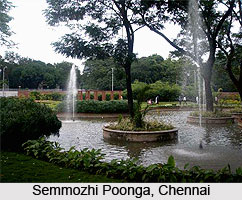 Semmozhi Poonga, which implies `Classical Language Park`, is a beautiful botanical park which is present in Chennai, in the Southern Indian state of Tamil Nadu. The horticulture department of the Government of Tamil Nadu had established this park and it was opened for public viewing on 24th November, 2010.
Semmozhi Poonga, which implies `Classical Language Park`, is a beautiful botanical park which is present in Chennai, in the Southern Indian state of Tamil Nadu. The horticulture department of the Government of Tamil Nadu had established this park and it was opened for public viewing on 24th November, 2010.
Semmozhi Poonga is present in Cathedral Road, near the junction of Anna Salai, exactly opposite the American Consulate. Semmozhi Poonga occupies a total area of 20 acres and boasts of over 500 species of plants, along with as many as 80 trees which existed during the time of conception of this park. Many of these trees are known to be much more than 100 years old. Medicinal herbs, aromatic plants and some plants belonging to endangered species are found here. Several plants existent in this park have been imported from nations like Thailand and China and involve some `bonsai` varieties.
History of Semmozhi Poonga
The Woodlands Drive-In restaurant was present in the region where currently Semmozhi Poonga stands. The Agri Horticultural Society was also located nearby. This land which measured 18 acres was first sub-leased to hotelier K.Krishna Rau, by the Agri Horticultural Society in April, 1962. The annual Chennai Book Fair was arranged in the campus of this hotel in the year 1982. The fair was organised by BAPASI. The Tamil Nadu government had passed a motion which declared that the hotel should conclude its operations immediately. Finally, this restaurant stopped its functioning on 12th April, 2008. Following a case in the High Court, the land of this hotel was transferred to the government after a tedious legal war. It was then decided that this land would be utilized by converting it into a botanical garden, a greenhouse for preserving rare species of flora and also a research centre. The Supreme Court granted permission to the state for establishing the park on 13th November, 2009. The Classical Tamil Conference was held in this garden in the year 2010.
Garden at Semmozhi Poonga
Semmozhi Poonga comprises eight sub-gardens which possess various species of flora like bonsai, tree court, attractive gardens, mural walks and also an artificial pond. The design of this garden has been influenced by certain features of an Indian-Buddhist garden. A butterfly garden, theme garden, golden garden which displays plants which produce flowers in numerous shades of gold, water and rock garden, sunken garden and fern garden are the numerous interesting sections of Semmozhi Poonga. There are 22 areas which contain all these marvellous gardens. 25 thematic gardens, which include cascades and aromatic gardens, are also erected here. This unique park also shelters 90 spiral-shaped miniature trees which have been grown inside containers, besides a Bonsai garden which consists of trees with a height of 1 foot to 4 feet.
Located near the entrance of the park, there is an arch. Near this arch, there is a vertical garden which is a rare characteristic of this garden. An in-built irrigation and drainage system are the thrilling features of this vertical garden. This garden measures 14 feet high and 22 feet long and is believed to enhance the aesthetic beauty of the Semmozhi Poonga park. 7000 plants, belonging to 35 species cover the arch of this park. Scefflera, Dracaena, Krishnagantha, Lilies, Phyllodendron, Ophiophogon and many other kinds of flowering plants are existent in this park. For the purpose of easy irrigation within the park, the process of micro tube irrigation is organised. The butterfly garden has been built in the lovely shape of a butterfly, and this garden is situated beside the cascade fountains, near the Anna flyover. Over 30 species of plants can be observed in this unique butterfly garden.
The Aroma Garden in the Semmozhi Poonga Park welcomes birds and butterflies. The authorities have also constructed an amphitheatre inside this park, which has been decorated with concrete benches and ferns on the rear portion of the garden. This has been done to facilitate several cultural functions. Ramps for the disabled are also amongst the features of this park. There are various species of cacti which have diameters measuring about 45 cm. Rocks, white marble chips and pebbles were brought from Porbandar in order to adorn the garden of the cacti. Water-lilies and orchids from Thailand were also imported to beautify this park.
Visiting Information
Visitors can visit this park within 6 am to 8am, particularly the morning walkers. For ordinary tourists, the park can be accessed from 10 am to 8pm regularly, except on Tuesdays. Parking facilities are also available in the premises of this park. More than 100 cars and 500 two wheelers can be easily parked in the premises of this park.



















